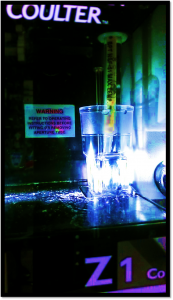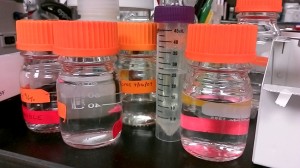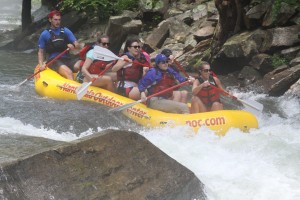If you are local to the Triangle and looking for something to do this month, consider coming out to SPARKcon. I’ll be there from 10 until 4 on Saturday 9/14 helping teams of students manage the STEAMSPARK Station, a tent where kids teach other kids about science through hands-on activities. Bring your family, come say hi, and maybe you’ll even get to play the Banana Piano!
Author Archives: kenan fellow
Week One
If this summer has left me with anything, it has left me with the command to be fearless in my teaching. The summer was hard in ways I could not have imagined in April, and yet, here we are, in August, still standing. I am stronger than I thought. I can do.
And I need to. So many of my children bear scars from past battles lost, and they bring their demons with them each day. They fear failure. They fear success. They fear alienation from their communities. They fear alienation from themselves. They fear. So I need to be fearless for my students, to model the fearlessness they will need in their own lives in order to rail against the dehumanizing processes that threaten learning.
I have been thinking about the dehumanization of education because, on August 14, I sat for the GRE. I felt fear in the days leading up to the exam. I cringed as I heard my voice in my head reciting the familiar testing strategies that we pretend to be important. I squirmed as my name transformed in to a number, trapping me into the rigid performance of “testing.” And I cried as I recognized practices in my school and countless other well-meaning schools contained within the extreme dictates placed upon me that day. I realized that when we strip our students of their dignity, when we turn them into numbers and erase their names, when we systematize and organize to meet our own needs without counsel or consultation, we feed their fears.
Teaching and learning should be acts of joy. This year, I will be fearless in advocating for my students’ humanity, starting with my class rules. I will be fearless so they can be fearless. I will be fearless because I can. And I know I can, because I survived this summer.
A Small Corner of the World
A post office, two gas stations, seven churches, and one school.
Add in a feed store, a factory, and Missy’s Grill, and you’ll have much of Efland. Our tiny hamlet is not well known, except as an exit off the highway. (In fact, when giving directions, I ask people if they know “Elf-land” and we go from there.) And yet, it is my world. Tiny Efland holds deep those nearest to my heart. They are sheltered beneath its trees, nurtured by its streams, fed by its fields. Its gentle, not-really-wilderness of buzzing insects, poison ivy, and rotting-log-kingdoms affords a level of biodiversity not as easily found in the manicured neighborhoods of nearby towns.
My love letter to my adopted home was inspired by Rob Dunn’s guest blog for Scientific American. In the article, he traces out the possible connections between trees, people, and insects, both plain and exotic. We know so little, still, about our world; there are so many places we haven’t thought to look.
For my students, so many places remain hidden, often obscured by curtains of poverty, culture, or language. Many have never left our county. Some have never left Efland. As I think about the year, I want to help them connect to the scientists with whom I have been fortunate enough to work, scientists from around the wide world who even speak the same language. I want to help my students connect to their own passions through 4-H. And I want to help them see, Matrix-style, the marvelous, mostly unknown, microbial world they inhabit and to which they are fundamentally connected.
I want to peel back the curtains for them, to bring forth for them the world, so that they may better love our small corner of it.
Almost finished the video I created about my lab. But in the mean time, here is a link to most of the photos I have taken to document this experience for my students. One day, I might even get around to editing the photos and cleaning them up.
Fluoresce

(This machine doesn’t actually use fluorescence, but it was far more photogenic than the machine that did. Coulter counters count cells using changes in impedance. Sorry about sacrificing scientific accuracy in the name of art. It’s the designer in me.)
In our lab, we used Picogreen, a reagent used to sort out double-stranded DNA from RNA, single-stranded fragments, and random free nucelotides. When the reagent encounters double-stranded DNA, it binds to the molecules and fluoresces. Keeping track of the fluorescent signals helps the scientists to know more about the quality of their samples.
I’ve been feeling rather like a free nucleotide floating in the miasma for much of this project. The past week, however, I had to put together a slide show for my lab explaining what I learned, and I realized that more “stuck” than I realized. I missed the individual signals, but found substance in the aggregate.
So my fluorescent moment is that learning can be slow and subtle, even to the point where we might miss it on the first scan. But once the catalyst starts to work, and we know what to look for, those tiny points of light coalesce into something illuminating, brilliant, beautiful.
One Giant Leap
40 years ago last week, Neil Armstrong stepped on the moon.
The computer system that guided Armstrong, Aldrin, and Collins on their iconic flight was less powerful than a USB thumb drive.
This story has been running through my head over the past week as I have been musing the question about implementing the Common Core, NC Essentials, and digital learning tools. On one hand, I do think that the standards will have more administrators paying attention to whether or not teachers are using digital learning tools. On the other hand, I also think that, without a clear understanding of what “implementation” can mean, we will end up with more stories like the one Christina Lowman shared, wherein “ELMO on” is interpreted as “digital learning.”
As educators, it is incumbent upon us to talk about what “implementing digital learning tools” means, and to remember that it isn’t the technology but the tool-user that is our moonshot. In what ways are we helping students use digital learning tools so that they make take their own giant leaps?
Curriculum
On the long drive home from Raleigh tonight, the thought occurred to me that writing curriculum is akin to writing poetry. It’s easy to get distracted by the how, the words, the activities, the we coulds, and so difficult to stay focused on the what, the big ideas, the spaces and rhythms, the multiple layers compressed into the most spare, efficient use.
My verbosity shows my hand. I need to seek poetry.
Fumbling Towards the Clear Blue
DNA polymerase, transcriptome, amplicon, pyrosequencing…
I teach elementary school.
So far, much of what I’ve encountered in the lab has involved highly technical aspects of molecular genetics, all of which is completely new to me. I’ve been able to connect the work obliquely to important things my students need to know (scientific notation, microorganisms exist everywhere, many different people choose to become scientists), and I’m sure more connections will pop up once the back burner does its work. But those connections are of secondary importance.
Right now, the piece I will hold most dearly when I am once again with my students is the lost; the feeling of helplessness that pervades so much of my time in the lab; the frustration at trying to run full pace up a mountainside without a path, map, or proper shoes. I am grateful for Belen’s wise and patient teaching and for the support of lab mates Vicky and Cassandra. But I am a driven person, and the feeling of being the weak link gnaws at me. The mountain is as much my own ego as anything else.
As a specialist in gifted education, I work with students who are also driven. They, too, teeter on the brink between an all-consuming hunger for knowledge and a total, paralyzing fear of failure. Like me, they often veer towards safer passages rather than bushwhack their way through unknowns.
I think back to students who brought forth tears when pushed into that gray area. “I will hold you close,” I have said to them, “but there is no turning back. I need you to head this way.” I tell myself that now with each tiny new word added to my lexicon, each remembered step, each molecule of knowledge: each hard-won fingerhold en route towards the clear blue.
Hacked
Technophile?
Luddite?
Earlier today I read an article on the computer-controlled cockroaches at NCSU, and I could hear the sci-fi (g)rumblings of the tech-no-philes growing in my head. Equally, the sci-fi promises of technophiles (in the conventionally-spelled manner) also rang out. But practically, what might this brave new world mean, particularly in the context of elementary education?
Cybernetic cockroaches aside, technology in the classroom is maybe a little less brave/new than either side would like to admit. I remember when my (personal) elementary school won an Apple IIe from the grocery store, and getting to use it to program triangular turtles FWD 25. Before that, overheads made think-alouds more transparent (pun sort-of intended), and even earlier, my parents ducked-and-covered to filmstrips intended to bring a touch of movie magic to mandatory matinees (ding). Pencils, pens, mimeographs, textbooks, hornbooks, styluses, tablets (stone or otherwise), each era has had some sort of tool at the ready to disseminate information.
So in some ways, the idea of “new” technology in the classroom is a continuation of what has always been there. Filmstrips begat overheads begat Powerpoint begat Prezi, with mutants, sports, hybrids, and other adaptations along the way. On the other hand, the promise of a truly individualized learning environment never really materialized. Even more, the dark shadows at the edges of this Utopian dream seemed to multiply as rapidly as technologies do today. Are people too dependent? Can we still pay attention? Can we survive? What are the implications for access/restriction of access?
As a teacher in a high-poverty school, I wrestle daily with these shadows. I watch my children, either plugged in and downloading or staring jealously from the side. What strikes me, though, in both cases, is how my students think about technology. They see it as unlimited infotainment, tidbits of interesting available for their consumption. It is everyday magic and unquestioned.
This, to me, is the most interesting challenge I face in leveraging technology, and one that extends beyond the question of accessing the Internet to watch a flipped video. To me, this challenge is about the very stuff of education: teaching for freedom. In his book, Radical Equations, Bob Moses frames education as a civil right in that it makes individuals and communities more free. In our post-modern age, I believe that teaching for freedom includes enabling students to reclaim the old meaning of technology, to re-define technology as a tool that they can control, manipulate, and re-mix in their own quests for freedom.
I have posted before about the Maker Movement, and I still feel that the Maker spirit is one way to reclaim technology. For example, at Maker Faire NC this year, tatters, 3D printers, and a trebuchet shared the same venue. Though the technologies showcased differed in electronic components and associated time periods, all displays showcased people learning, sharing, and pushing the boundaries of the tools available to them in order to realize their personal dreams, to become more free in the existential sense. This is the technology I strive for in the classroom.
Bend
After a detour to retrieve two of my children from Camp Grandparents, I’ve finally been able to let the sediments settle in my head.
This week eroded my brain. Like the stream capturing the river, my sense of direction and safety have been pulled off in an unexpected direction. And that isn’t necessarily a bad thing.
To be honest, I am terrified about this Fellowship. My last biology class was 20 years ago so my externship to date has been a crash course in cellular biology — that, and me wondering at night how to translate the information to young children without inadvertently oversimplifying to the point of misconceptions. I am afraid of failing my students and the team.
The techno-frustration of this week is an important takeaway for me; not because I want to dwell in frustration, mind you, but because it forced me to place myself in the position of a student and recognize that frustration does pass, that time smooths edges and exposes new paths. I will be frustrated in this Fellowship because I will be learning in this Fellowship, and so I will need to hold tight to geologic time. I can flex. I will not break.
Thankfully, I am not alone. I have a team to help guide me around the bend.


